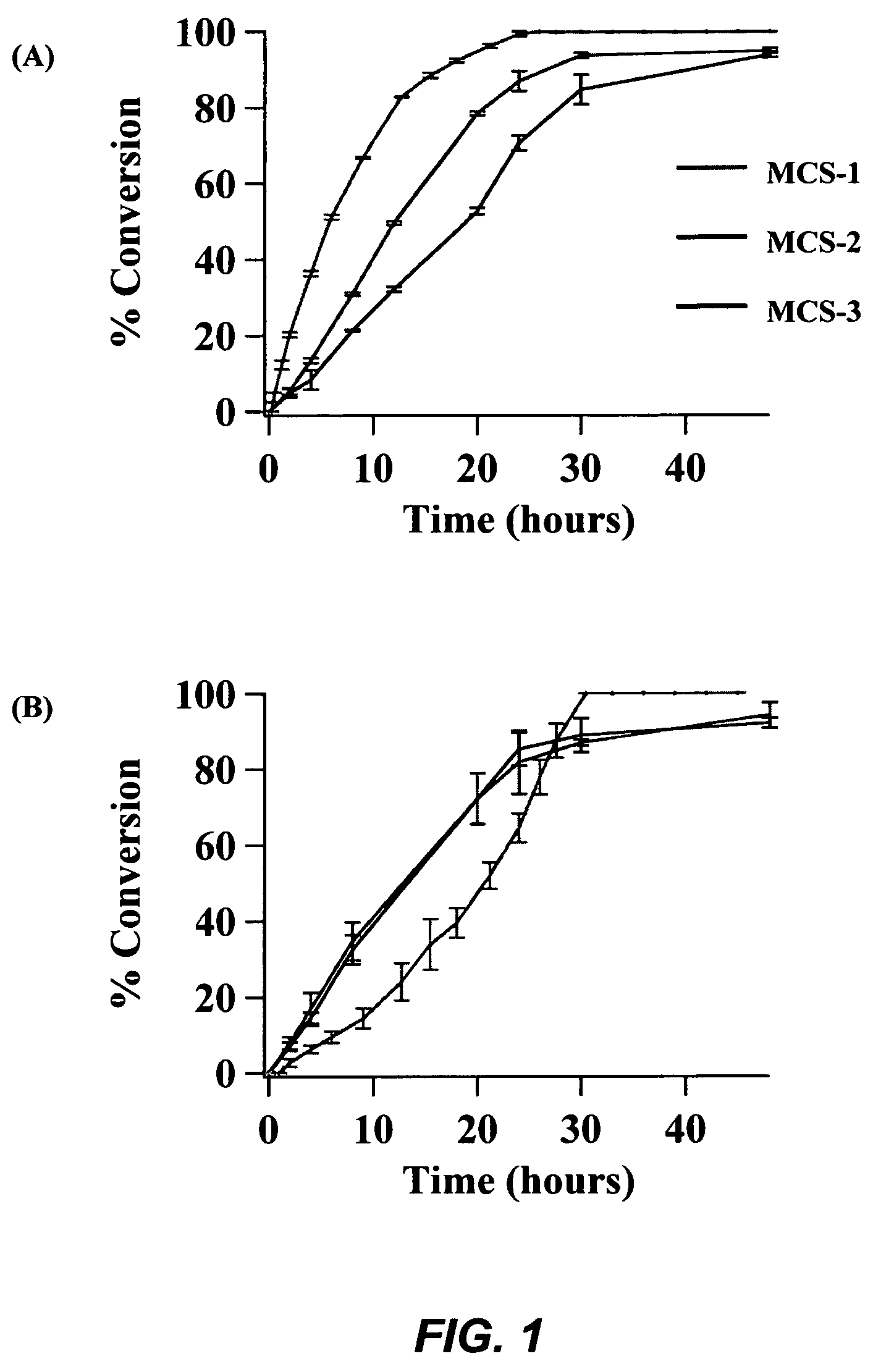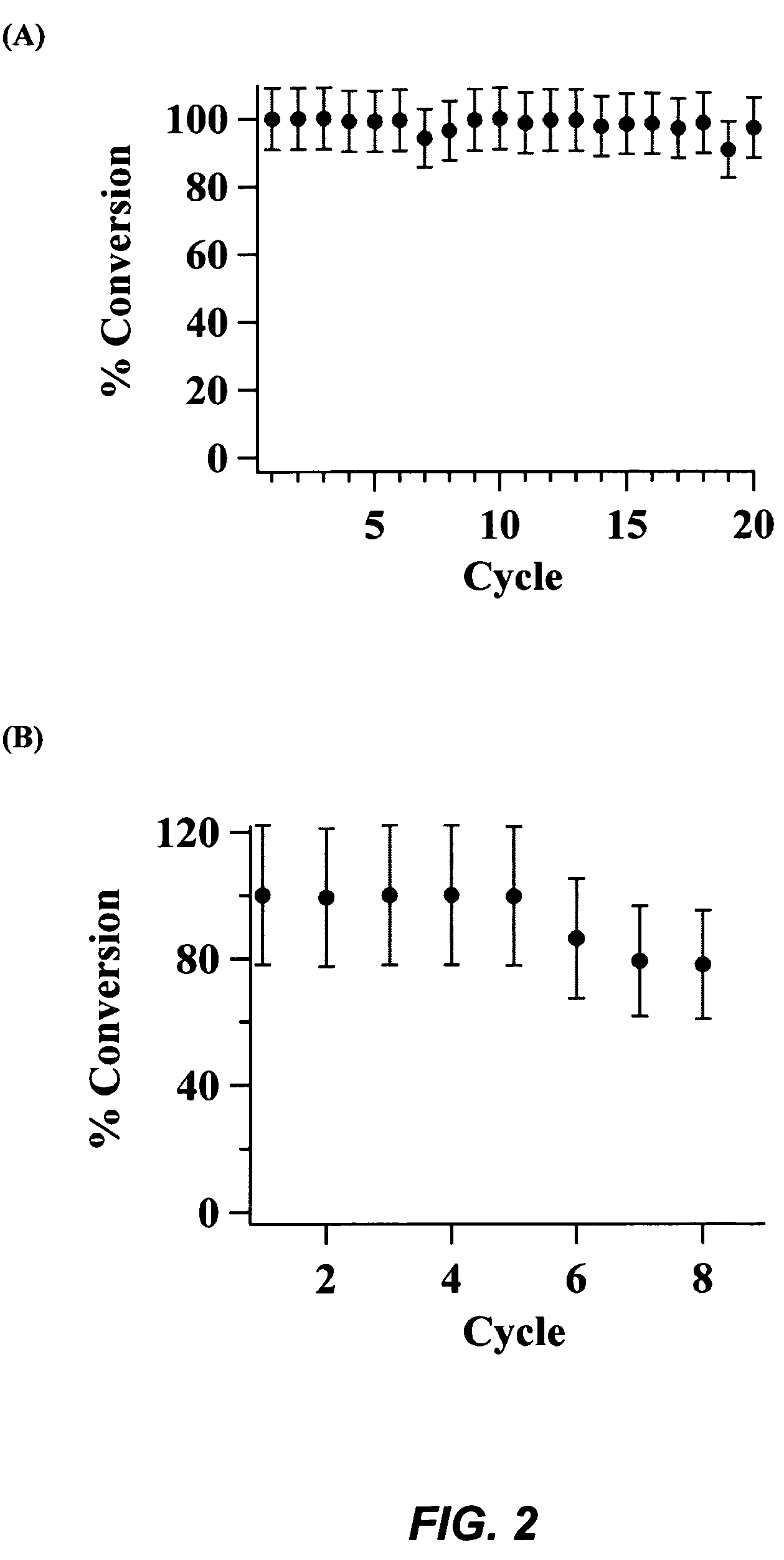Porous silica and metal oxide composite-based catalysts for conversion of fatty acids and oils to biodiesel
a technology of composite-based catalysts and porous silica, which is applied in the direction of physical/chemical process catalysts, fatty oil/acid recovery from waste, and fatty oil/fat refining. it can solve the problems of shortening the lifespan of base catalysts, poor recycling of solid base catalysts, and shortening the life of base catalysts. it is easy to separate from reaction mixtures, and is easy to recycle. , the effect of significant economic benefits
- Summary
- Abstract
- Description
- Claims
- Application Information
AI Technical Summary
Benefits of technology
Problems solved by technology
Method used
Image
Examples
example 1
Preparation of Biodiesel Catalysts
Part I. Preparation of Mesoporous Calcium Silicate (MCS) Catalysts:
[0091]The preparation of mesoporous calcium silicate (MCS) catalysts involves a co-condensation reaction to create a mixed metal oxide system. Cetyltrimethylammonium bromide (CTAB) surfactant micelles template the formation of the mixed metal oxide material, in a NaOH-catalyzed condensation reaction of tetraethoxysilane (TEOS). The catalysts were synthesized by first dissolving n-cetyltrimethylammonium bromide (CTAB, 2.74 mmol) in 480 mL of 15 mM NaOH(aq). This solution was heated to 80° C., followed by a dropwise addition of tetraethylorthosilicate (TEOS, 22.4 mmol). White solids were observed in the initially opaque emulsion 90 seconds upon mixing. CaO was added slowly to the stirring solution during the TEOS addition process. The reaction was vigorously stirred at 80° C. for 2 hours, followed by hot filtration of the as-synthesized MCS product. The as-synthesized material was wash...
example 2
Evaluation of Biodiesel Catalysts
Part I. Soybean Oil Esterification:
[0095]Methanol (0.3 mol) was added to 100 mg of the calcined MCS catalyst, and the resulting solution was stirred 15-20 minutes at room temperature to uniformly disperse the catalyst. Utilizing the MCS-1 catalyst, the soybean oil (0.5 g) was added to the catalyst solution, and the reaction mixture was stirred under reflux at 80° C. for 26 hours. After 26 hours, the reaction mixture was filtered on a glass frit and rinsed with minimal methanol for transfer. The filtrate was evaporated under vacuum and analyzed by 1H NMR. The MCS-2 and MCS-3 catalysts required 48 hour reaction times with the above procedure to complete conversion, due to lower calcium oxide loading.
[0096]After further investigation, it was determined that a lower catalyst loading could likewise result in complete conversion to methyl esters. Merely 25 mg of the calcined MCS-1 catalyst can be employed to convert 0.5 mL of soybean oil to methyl esters i...
example 3
MCS / Metal Oxide Blend Catalysts
Part 1. Catalytic Performances of a Solid Blend of CaO / MCS Catalysts.
[0124]Solid Blend of CaO with MCS-1: Methanol (0.3 mol) was added to a solid blend consisting of 50 mg of CaO and 50 mg of calcined MCS-1 catalyst. The resulting mixture was stirred at 80° C. to uniformly disperse the catalyst. After stirring for 30 minutes, soybean oil (2.5 mL) was introduced and the reaction mixture was stirred at 80° C. The complete conversion of soybean oil to biodiesel took 40 minutes as depicted in FIG. 9. The crude product mixture was filtered through a glass-fritted funnel. The product-containing filtrate was evaporated under vacuum to remove methanol. The yield of methyl esters (biodiesel) was analyzed by 1H NMR.
[0125]Solid Blend of CaO with MCS-2: By following the aforementioned procedures, a solid blend of CaO (50 mg) and calcined MCS-2 (50 mg) was found to be able to catalytically convert soybean oil (2.5 mL) to biodiesel within 2 hours as shown in FIG. 10...
PUM
 Login to View More
Login to View More Abstract
Description
Claims
Application Information
 Login to View More
Login to View More - R&D
- Intellectual Property
- Life Sciences
- Materials
- Tech Scout
- Unparalleled Data Quality
- Higher Quality Content
- 60% Fewer Hallucinations
Browse by: Latest US Patents, China's latest patents, Technical Efficacy Thesaurus, Application Domain, Technology Topic, Popular Technical Reports.
© 2025 PatSnap. All rights reserved.Legal|Privacy policy|Modern Slavery Act Transparency Statement|Sitemap|About US| Contact US: help@patsnap.com



